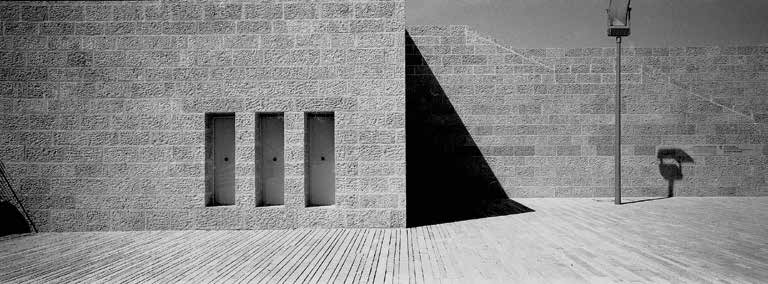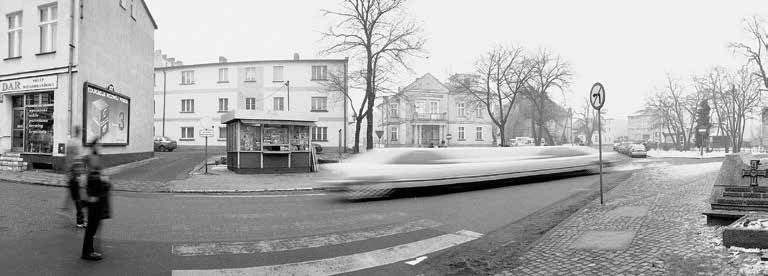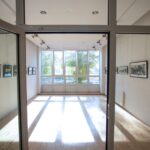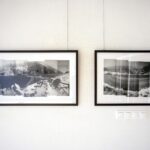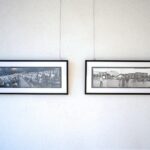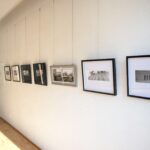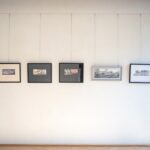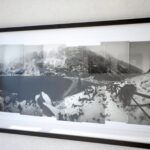Zmagania z panoramą
Das Ringen um das Panorama
Struggling With the Panorama
Artysta | Künstler | artist: Waldemar Śliwczyński (1958)
miejsce | Ort | place: Galeria Mała | Kleine Galerie | Small Gallery
Słubicki Miejski Ośrodek Kultury SMOK, ul. 1 Maja 1, Słubice
Format panoramiczny fascynuje mnie od wielu lat, bo pokazuje obraz w sposób zbliżony do tego, jak ludzie widzą świat. Wystawa przedstawia proces, jaki przeszedłem w tworzeniu fotografii w tym formacie. Był on determinowany przede wszystkim sprzętem, jaki miałem do dyspozycji w różnych latach. Zacząłem od Horyzontu z jeżdżącym obiektywem (patrz Poczta) oraz podobnego do niego konstrukcyjnie Noblexu. Bawiłem się też wtedy nietypowym wykorzystaniem jeżdżącego obiektywu, który obiekty poruszające się zgodnie z kierunkiem obiektywu wydłużał (patrz W 2003 do małego miasteczka przyjechał Elvis Presley), a w przeciwnym – ścieśniał. Dopiero analogowy małoobrazkowy Hasselblada Xpan II zlikwidował problemy techniczne (patrz Yad Vashem). Zawsze zależało mi na wiernym odwzorowaniu rzeczywistości, bez zniekształceń. Dlatego zacząłem budować panoramy stykowe z pojedynczych kadrów (poziomych i pionowych) z negatywów wielkoformatowych 4×5 cala oraz 5×7 cala (patrz Śląskie przeboje). Moim najnowszym pomysłem na tworzenie poziomych panoram jest zestawianie ich z pionowych panoramicznych kadrów z Xpana (patrz Samotnia). Widzę w tym sposobie fotografowania spory potencjał.
Das Panoramaformat fasziniert mich seit vielen Jahren, weil es Bilder auf eine Art und Weise zeigt, die der Sichtweise der Menschen auf die Welt nahe kommt. Diese Ausstellung zeigt den Prozess, den ich bei der Erstellung von Fotografien in diesem Format durchlaufen habe. Bestimmend war vor allem die Ausrüstung, die mir in den verschiedenen Jahren zur Verfügung stand. Ich begann mit einer Horizon mit Fahroptik (siehe Post) und einer Noblex, die ähnlich aufgebaut war. Zu dieser Zeit spielte ich auch mit dem ungewöhnlichen Einsatz des beweglichen Objektivs, das Objekte, die sich in Richtung des Objektivs bewegten, verlängerte (siehe 2003 kam Elvis Presley in eine Kleinstadt) und in der Gegenrichtung schrumpfte. Erst mit der analogen Kleinbildkamera Xpan II von Hasselblad wurden die technischen Probleme beseitigt (siehe Yad Vashem). Ich war immer an einer originalgetreuen, unverzerrten Darstellung der Realität interessiert. Deshalb habe ich begonnen, Kontaktpanoramen aus Einzelbildern (horizontal und vertikal) von 4×5- und 5×7-Zoll-Großformatnegativen zu erstellen (siehe Schlesische Schlager). Meine neueste Idee für die Erstellung horizontaler Panoramen besteht darin, sie aus vertikalen Panoramabildern von Xpan zusammenzusetzen (siehe Samotnia). Ich sehe in dieser Art des Fotografierens ein großes Potenzial.
The panoramic format has fascinated me for many years because it shows the image in a way close to how people see the world. The exhibition shows the process I went through in creating photographs in this format. Primarily, it was determined by the equipment I had at my disposal at the time. I started with a Horizon with a swing lens (see Post) and a Noblex, similar in design. At the time, I was also playing around with the unusual use of the swing lens, which lengthened objects moving in line with the direction of the lens (In 2003, Elvis Presley Came to a Small Town) and shrunk them, when they moved in the opposite direction. It was not until Hasselblad’s analogue small-image Xpan II that the technical problems were eliminated (Yad Vashem). I have always been keen on a faithful, undistorted representation of reality. That’s why I started building contact panoramas from single frames (horizontal and vertical) from negatives 4×5 inches and 5×7 inches (Silesian hits). My latest idea for creating horizontal panoramas is to put them together from vertical panoramic frames from Xpan (Samotnia). I believe that this way of using photographs has a lot of potential.
